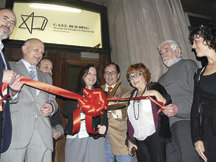Fans of art produced from the 1950s through the end of what was previously known as the Soviet Union (now Russia and its neighboring countries) are in for a treat as the Museum of Russian Art reopened in Jersey City this month.
The museum was originally opened in 1980 by Russian art collector Alexander Glezer in a building owned by controversial former Wall Street financier Arthur A. Goldberg, who had helped resettle Soviet immigrants in Jersey City. Previously known as the C.A.S.E (Committee for the Absorption of Soviet Émigrés) Museum of Contemporary Russian Art, it can be found on the second floor of a three-story brownstone on Grand Street in downtown Jersey City.
“Over the last decade there has been almost nothing here.” – John Narins
________
Now Glezer is resettled in Paris and a new group of Russian art aficionados has taken on the task of restoring the museum. They want to revive its mission to display creations that fetch top dollar on the art market.
A sizable crowd was present for a reopening on Nov. 13. The event included pieces by Nonconformist notables like Oleg Vassiliev and Erik Bulatov as part of the exhibit, “NO EXIT ART: Works on Paper by Nonconformist Artists from the 1950s through the End of Soviet Era.” It also displayed works by post-Nonconformist artists Elena Sarni, Leonid Lerman, and Vasily Kafanov.
The post-Nonconformists were on display for only the reopening weekend, while the No Exit Art show will continue until the end of the year.
Rebel art in the public eye
The Nonconformist art seen by the audience appeared in various forms.
Sketches, watercolors, and mixed media art were presented from different schools of thought within the Nonconformist faction. These included realism and conceptualism, as well as subgroups like Sretensky Boulevard and Lianozovo.
John Narins, one of the directors of the reopened museum, said such a massive showing of this art has not happened in this space in years. He said the Nonconformist art was referred to as such because it did not follow official guidelines for art that the Soviet government set down for artists to follow.
He also pointed out the museum was completely renovated in the past year with the help of fundraising. The museum space is being rented from the building’s owner.
Narins said the reopening meant the launching of a new “full-service” facility that will feature not just art, but also concerts and educational programs on Russian history as well as concerts.
The museum will be open three days per week.
“Over the last decade there has been almost nothing here, the whole enterprise died,” Narins said.
Margo Grant, a collector of Russian art for over 30 years who serves on the museum’s board of directors, said this art does not get seen often in the Tri-State area, never mind in the United States.
Also present for the reopening were art collector Dan Frohwirth, who is also the director of real estate for the Jersey City Economic Development Corporation, and Grace Hanlon, acting executive director of the NJ Division of Tourism and Travel.
“We want cultural things to happen in Jersey City so we don’t have to go across the river,” Frohwirth said.
Elena Sarni showed off several of her sketches in the post-Conformist artists show, “The Story Doesn’t End There,” in the first-floor lobby of the C.A.S.E. building.
She said she was “honored” to be in a show with artists that she grew up studying.
“It is part of our heritage,” Sarni said. “But you know in art, nothing new; it is a combination of old.”
For now, the museum at 80 Grand St. is open Friday and Saturday from 1 to 6 p.m. For more information, call (201) 332-9200 or visit: http://www.moramuseum.org.
Ricardo Kaulessar can be reached at rkaulessar@hudsonreporter.com.
